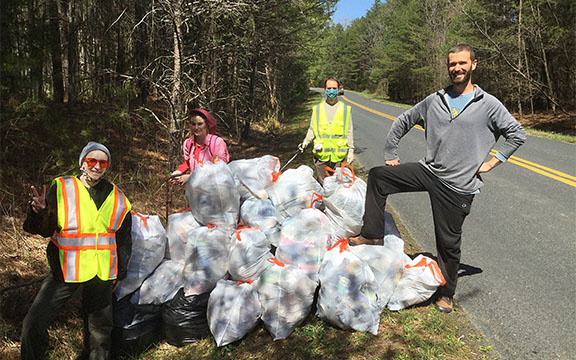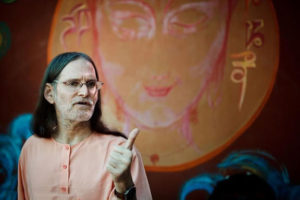
Yogaville Community Karma Yoga project, 2021. Photo by Bill Geoghegan
I don’t know about you, but the spirit of sacrifice and service has never come easy for me. In the early days of my spiritual journey, due to my self-absorption in “taking care of Number 1,” I used to cringe whenever Swami Satchidananda (Gurudev) talked about Karma Yoga—which was pretty much every time he spoke.
With reticence, I accepted that service was the dues I needed to pay to join “The Spiritual Seeker Club.” I figured it was the “hazing” that new members were forced to endure to be accepted in the fraternity. Once I was a full-fledged member then I could get down to the “real” practice of Yoga. That was my understanding in those early years and gratefully I outgrew that notion.
Before becoming a monk—now 47 years ago as I write this—I probably should have read the fine-print in the “swami manual”—the part about living for God and serving all the names and forms that are, in essence, God. Thankfully, the truth dawned on me: Karma Yoga is a must for me. While I experience the tremendous benefit of all the teachings of Gurudev—including asana, pranayama, and meditation and would never consider giving them up—I am finally beginning to understand his emphasis on selfless service.
As long as we spend most of our time in the experience of the body/mind being “me,” and the desire for Self-Realization is competing with a bunch of other desires, then tamas and rajas are still prevalent in our heart and mind. I occasionally contemplate the idea that “I am That” (Jnana Yoga). And as best I can, I try to be more devoted to the Supreme Being (Bhakti Yoga). But the ego is a hard nut to crack, and, in my humble opinion, nobody gets established in the Truth of our essential-nature by force of will. This awakens in a sattvic mind.
I see now how Karma Yoga is essential for moving beyond rajas and tamas. Forget about selfless action, just finding any action that pauses our Netflix streaming and gets us off of our couches, begins to shakes off our tamas. It the selfless part that deals with rajas. A good start is being honest about our motivation for our actions. Usually, if I look closely enough, I can uncover some personal reason and benefit that I am looking for. But, at least, now I’m also acting out of care for another person; it is not all about me. I may not be able to “give until it hurts,” as Mother Theresa recommended, but I can feel a good stretch as I move outside my comfort zone.
So, I try each day to live up to Gurudev’s guidance: “The dedicated enjoy Supreme Peace; therefore, live to serve.” The Sanskrit word for dedication is tyagat. It can also be translated at letting go, renunciation, and surrender. Tyagat means first letting go of the result of the action. But, ultimately, tyagat means letting go of the illusion of a self separate from the whole that is performing the action. The separate self—the ego—can never enjoy Supreme Peace; it is what’s in the way of the experience of that Peace.
The way I now understand Gurudev’s teaching is: Those who have let go of the illusion of separateness experience their essential nature as Supreme Peace, and have no other purpose for living but to be of service.
I believe that the practice of Karma Yoga is an attempt to recognize that the one true Self—the one essential nature that we all share—is performing actions through the instruments of the body/mind, which I falsely assume to be “me,” or a separate self. The dissolution of this sense of separate self will result in the experience of pure love and connection— and that is the true inspiration behind Karma Yoga.
Questions for Reflection:
- What is Karma Yoga for you?
- What obstacles have you found to the practice of Karma Yoga?
- Have you found any connection between your meditation practice and your capacity to offer pure Karma Yoga?
- Has the practice of Karma Yoga helped you to move more deeply into Jnana and/or Bhakti Yoga?
About the Author:
 Swami Asokananda, initiated into monkhood in 1973 by Sri Swami Satchidananda, is the spiritual director of Integral Yoga Institute of New York, co-director of the Integral Yoga Global Network, and one of Integral Yoga’s foremost teachers. He is the primary instructor for the Intermediate and Advanced Hatha Yoga Teacher Trainings offered around the world. He has deeply studied the Bhagavad Gita for many decades and is currently writing a commentary.
Swami Asokananda, initiated into monkhood in 1973 by Sri Swami Satchidananda, is the spiritual director of Integral Yoga Institute of New York, co-director of the Integral Yoga Global Network, and one of Integral Yoga’s foremost teachers. He is the primary instructor for the Intermediate and Advanced Hatha Yoga Teacher Trainings offered around the world. He has deeply studied the Bhagavad Gita for many decades and is currently writing a commentary.

